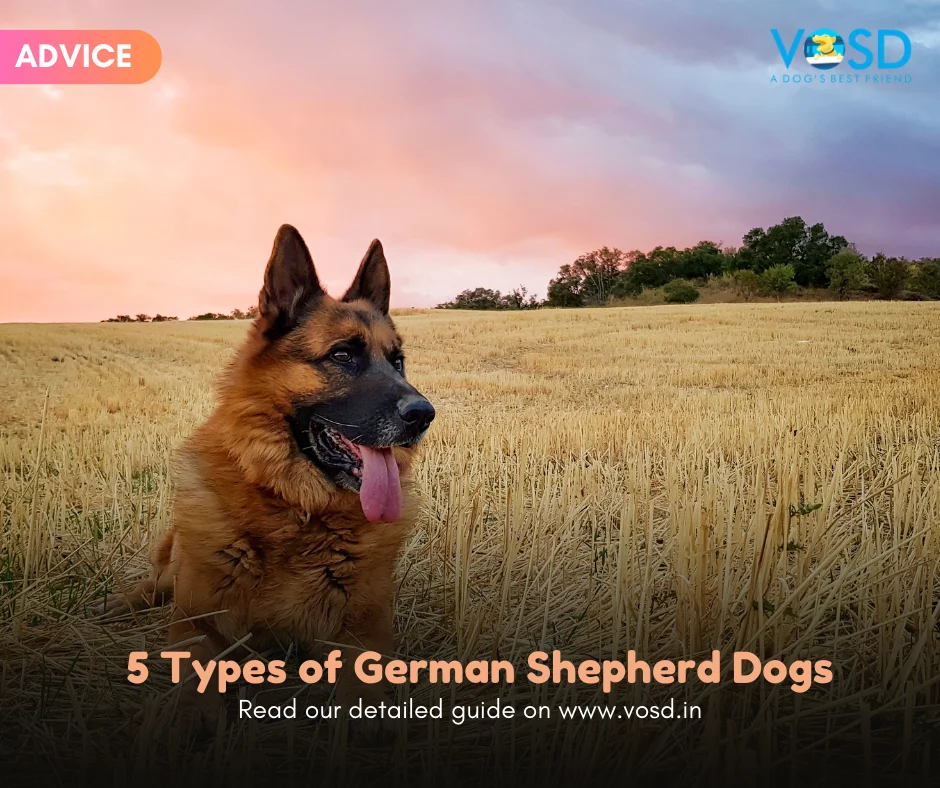German Shepherd dogs are among the most popular breeds that people have in their families. And why not! German shepherds are intelligent, have a distinctive personality, and they are relatively easier to train.
So, if you’re planning to welcome this breed of dog to your home, we get why!
But here’s the thing: There are different types of German Shepherd dogs. So, before you adopt one, it’s a good idea to have a fair idea of these “types”.
Types of German Shepherd Dogs
Black German Shepherd Dog
They are solid colour German Shepherds. These solid black dogs are not as common as the Saddle Back. Their colour is because of a recessive gene.
White German Shepherd Dog
A white German shepherd also belongs to the solid colour category. The solid white german shepherds do not qualify for a competition, unlike the solid black ones. The white colouring stems from a dominant gene in some of the litters. White German Shepherds are not very common.
Saddle coat German Shepherd Dog
The Saddle Back German Shepherd is the most common type of their breed. They have two colours, but the way they are marked on the body gives them the name of Saddle Back. The black fur on the back resembles a saddle’s shape and is also called a blanket pattern. The second colour can be either red or tan.
Panda German Shepherd Dog
The Panda German Shepherd is not very common, and their striking appearance sometimes can be confused with some other breeds. This type of breed is more because of a genetic mutation that happened in a litter. It shows a white coat on the legs and the abdomen but can be black or tan everywhere else.
Sable German Shepherd Dog
Sable German Shepherds are also known as ‘agouti’. This type of German Shepherd does not have patches of colour but have multi-coloured hair all over their bodies. The shades may be a blend of tan, black, grey, and gold. As puppies, they are tan in colour, and they develop the other colours as they grow older.
Working lines and show lines German Shepherds
German shepherds are also categorised based on their body type. In particular, there are Working line German Shepherds and Show line German Shepherds.
In the 1850s, dog breeding became standardised in Germany. The purpose was to have dogs that can assist the shepherds and keep the predators away from their flock. Max von Stephanitz advocated the idea of breeding working dogs and not merely show dogs. He was impressed by the dog’s ability and skill and believed that they could be bred for purposes other than dog shows. He created methodical programmes for breeding, and the working line dogs became popular. By focusing on the dog’s ability and its genes, Stephanitz successfully created the working line German Shepherd.
The primary difference between the working line and show line German shepherds is their purpose. Other equally important differences are their physicality and personality.
Purpose/ Function:
Working line dogs are bred and trained for the purpose of fulfilling functions in law enforcement. Their training is also in tune with the needs of law enforcement focusing on endurance and tolerance for pain.
Show line German Shepherds are raised with a focus on their appearance and are used more in dog shows or as pets.
Physical appearance:
Working line German Shepherds are thicker with a straight structure and can work for long hours. Show line German Shepherds are thinner and have a slanting back as their front legs are longer than their back legs. The coats of working line and show line German Shepherds are also different. The former can have any coloured skin whereas the latter may not qualify for a show if the colours are not black, black and tan, black and red, or black and silver. There are no such restrictions on working line German Shepherds.
Training:
Working line German Shepherds are always alert and can be aggressive. They are trained for the purpose of attack, and this training helps them develop a great degree of strength and intelligence. On the other hand, the show line German Shepherd tends to be calmer and domestic. They only become aggressive when they need to defend themselves.
Why have German Shepherds?
There are quite a few reasons why you could choose German Shepherd.
Intelligent
The German Shepherd tops the list of intelligent dogs. They have an acute sense of smell and can be heroic. They are easy to train and can be an asset to police departments.
Healthy
As long as German Shepherds are fed well meeting their nutritional needs, they rarely face health complications. They need regular exercise as they are highly energetic.
Easy to train
Their intelligence and alertness make them easy to train. German Shepherds are highly responsive to instruction and are fast learners.
Good for security
They make excellent guard dogs and are protective of your home. Companies specialising in security services often find German Shepherds most useful.
Very loyal
German Shepherd breed is one of the most loyal of breeds. They will always be ready to lay their life on the line for their family.
Need Medical Help for Your German Shepherd?
Whether you have a German Shepherd or plan to have one, if you need a second medical opinion, get in touch with a veterinary expert at VOSD.
The need to receive medical advice for your pet will never cease; therefore, VOSD has made it easier with digital access through any of your devices. All the information you need can now be available to you from your homes.
VOSD offers free veterinary service for the whole gamut from first aid to long term medical assistance needed in the case of diseases related to liver, cardiac, pancreatic, gallbladder regardless of your current location. As dog parents, you can use telemedicine for dogs service from VOSD, which allows you to seek online treatment for dogs from qualified veterinarians.








